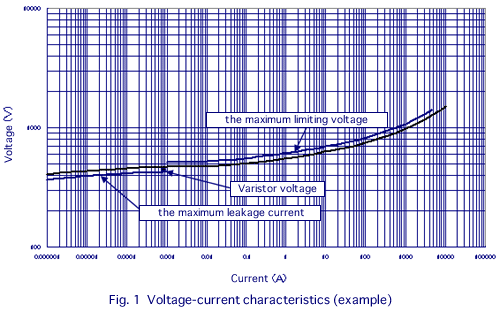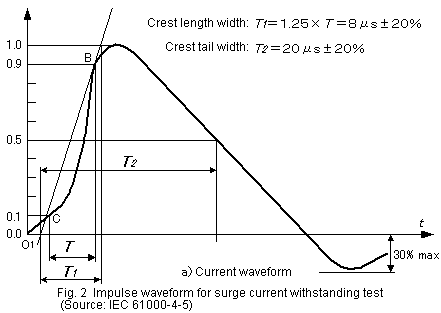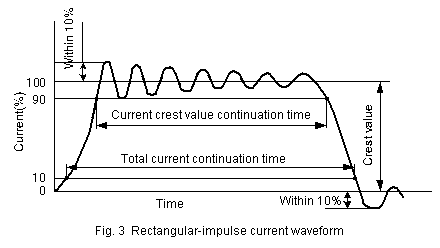Technical terms of MNR varistors
Click to make your choice from the following item.
![]()
Technical terms of MNR varistors
![]()
1. Varistor voltage
Varistor voltage is defined to be the voltage (V1mA) between varistor terminals when a 1mA current is flowed through a varistor.
Where varistors are small such as our 05D series and 1mA is too large in terms of heat, the voltage may be specified for a current of 0.1mA between varistor terminals (V0.1mA).
To ensure ease in choosing varistors best fitting application circuits, they are serialized by varistor voltages.
Where the same varistor materials are used, varistor voltages and thickness of varistors are proportional and the higher varistor voltages, the thicker varistors.
Press here to return to the top of this page
2. Maximum allowable circuit voltage
Maximum allowable circuit voltage is defined to be the upper limit of circuit voltages which can be continuously applied to varistors.
Application to varistors of voltages higher than the maximum allowable circuit voltage for a long time will impair their performance or damage them.
Maximum allowable circuit voltage is smaller than respectively defined varistor voltages in DC or AC.
Press here to return to the top of this page
3. Limiting voltage
Limiting voltage is the voltage at varistor terminals when a specified current (an8/20μs impulse signa: Please refer to sub-section, Surge current withstanding) flows through the varistor. The magnitude of currents are specified varistor-dependently and are in the vicinity of X = 1 through 100A.
Limiting voltage represents varistors’ absorbency of lightning surge. It is a characteristic necessary for designs protecting voltages higher than the limiting voltage from entry into circuits even though lightning surge enters it.
Specification values for the maximum limiting voltage in Fig. 1 are the upper limit of varistor terminal voltages including temperature characteristics and element variation
at currents larger than the current to be measured of varistor voltages.
Where the same varistor materials are used, limiting voltages are nearly proportional to varistor voltages and the larger the element diameter, the lower limiting voltage.
Press here to return to the top of this page
4. Leakage current
Leakage currents are defined to be the current when the maximum allowable circuit voltage is applied. They are as small as about 100μA at most.
The specification value for the maximum leakage current shown in Fig 1 defines the upper limit of the current flowing through varistors, including the varistor voltage tolerance.
If an AC voltage is applied, a current due to capacitance will be added to the leakage current.
Press here to return to the top of this page
5. Capacitance
Varistors behave like capacitors because varistors are fed with voltages lower than the maximum allowable circuit voltage.
Their capacitance will be proportional to the square of varistor diameters. The lower the varistor voltage, the larger the capacitance which will be a couple of tens of pF to a couple of tens of thousand of pF.
Press here to return to the top of this page
6. Surge current withstanding
Surge current withstanding represents varistors’ surge absorption ability. Whether varistors can absorb surges or they will be impaired or damaged depends on the magnitude of the surge current applied and its duration.
Lightning surges breaking in from wattage lines can be substituted with an impulse current waveform called 8/20μs (T1/T2) waves. Surge current withstanding is, therefore, measured with this waveform.
8/20μs waveforms can be interpreted as impulse waveforms with the crest length width (T1) being 8μs and the crest tail width being 20μs.
[Crest length widths are lengths of time between the point (virtualization time) where a time axis, which is extrapolated at 0%, crosses, and a point extrapolated at 100% on a straight line connecting 10% and 90% values of the crest value. Crest tail widths are lengths of time between the virtualization time and the 50% value (half the wave crest) of rising.]
Press here to return to the top of this page
7. Surge energy withstanding
Surge energy withstanding represents evaluation of surges having a wave tail length longer than surge current withstanding.
Normally, 2 ms rectangular waves shown in Fig. 3 or 10/1000μs (T1/T2) waveforms are used. Evaluation will be made based on energy figures to be absorbed by varistors, not on the magnitude of surge current.
Surge energy withstanding will be evaluated by the rate of change of varistor voltages as with surge current withstanding, and impairment will proceed likewise. However, it is not proportionally related with values of surge current withstanding.
Surge energy withstanding is in a proportional relationship with the cubic volume of varistors and depends on their diameters and thicknesses.








